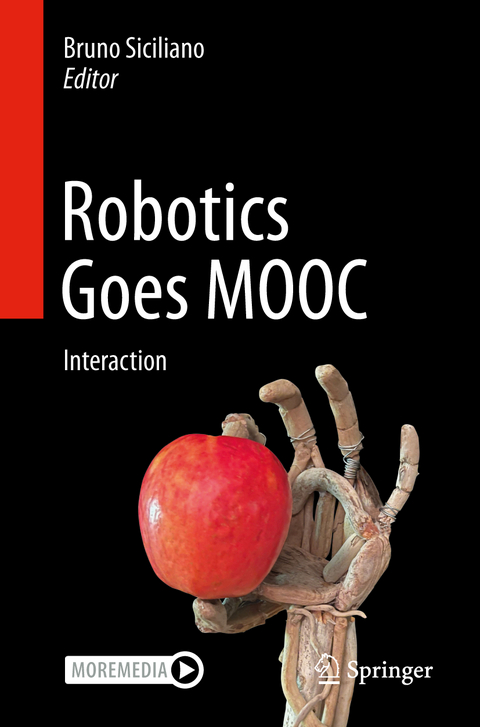
Robotics Goes MOOC
Springer International Publishing (Verlag)
978-3-319-77269-1 (ISBN)
- Noch nicht erschienen - erscheint am 18.03.2025
- Versandkostenfrei innerhalb Deutschlands
- Auch auf Rechnung
- Verfügbarkeit in der Filiale vor Ort prüfen
- Artikel merken
With the massive and pervasive diffusion of robotics technology in our society, we are heading towards a new type of AI, which we call Physical AI at the intersection of Robotics with AI, that is the science of robots and intelligent machines performing a physical action to help humans in their jobs of daily lives. Physical assistance to disabled or elderly people; reduction of risks and fatigue at work; improvement of production processes of material goods and their sustainability; safety, efficiency and reduction of environmental impact in transportation of people and goods; progress of diagnostic and surgical techniques are all examples of scenarios where the new InterAction Technology (IAT) is indispensable.
The interaction between robots and humans must be managed in a safe and reliable manner. The robot becomes an ideal assistant, like the tool used by a surgeon, a craftsman, a skilled worker. The new generation of robots will co-exist - the cobots- with humans not only in the workplace but, gradually, in homes and communities, providing support in services, entertainment, education, health, manufacturing and care.
As widely discussed above, interaction plays a crucial role for the development of modern robotic systems. Grasping, manipulation and cooperative manipulators are covered in the first part of the third book of the Robotics Goes MOOC project, respectively in Chapter 1 by Prattichizzo et al, Chapter 2 by Kao et al, and Chapter 3 by Caccavale. Specific interaction issues along with the development of digital and physical interfaces are dealt with in Chapter 4 by Marchal et al and in Chapter 5 by Croft et al, respectively. Interaction between robot and human also means that a robot can be worn by a human as presented in Chapter 6 by Vitiello et al. A different type of interaction at a cognitive and planning level is the focus of Chapter 7 by Lima devoted to multi-robot systems and Chapter 8 by Song et al on networked, cloud and fog robotics, respectively.
Bruno Siciliano received his doctorate degree in Electronic Engineering from the University of Naples, Italy, in 1987. He is a professor of Control and Robotics at the University of Naples Federico II. His research focuses on methodologies and technologies in industrial and service robotics, including force and visual control, cooperative robots, human-robot interaction, and aerial manipulation. He has co-authored 6 books and over 300 journal papers, conference papers and book chapters. He has delivered more than 20 keynote presentations and over 100 colloquia and seminars at institutions around the world. He is a fellow of IEEE, ASME and IFAC, and co-editor of the Springer Tracts in Advanced Robotics (STAR) series and the Springer Handbook of Robotics, which received the PROSE Award for Excellence in Physical Sciences & Mathematics and was also the winner in the category Engineering & Technology. He has served on the editorial boards of prestigious journals, as well as chair or co-chair for numerous international conferences. Professor Siciliano is the past president of the IEEE Robotics and Automation Society (RAS). He has been the recipient of several awards, including the IEEE RAS George Saridis Leadership Award in Robotics and Automation and the IEEE RAS Distinguished Service Award.
1 Domenico Prattichizzo, Maria Pozzi and Monica Malvezzi, Grasping.- 2 Imin Kao and Carlos Saldarriaga, Manipulation.- 3 Fabrizio Caccavale, Cooperative Manipulators.- 4 Maud Marchal and Claudio Pacchierotti, Virtual Reality and Haptics.- 5 Elizabeth Croft, Wesley P. Chan, and H.F. Machiel Van der Loos, Human-Robot Interaction.- 6 Emilio Trigili, Zach McKinney , Simona Crea and Nicola Vitiello, Wearable Robotics.- 7 Pedro U. Lima, Multi-Robot Systems.- 8 Dezhen Song, Ajay Kumar Tanwani and Ken Goldber, Networked, Cloud and Fog Robotics.
| Erscheinungsdatum | 03.12.2023 |
|---|---|
| Zusatzinfo | Approx. 200 p. |
| Verlagsort | Cham |
| Sprache | englisch |
| Maße | 155 x 235 mm |
| Themenwelt | Technik ► Elektrotechnik / Energietechnik |
| Schlagworte | Design • Impact • interaction • Knowledge • Moocs • Robotics |
| ISBN-10 | 3-319-77269-4 / 3319772694 |
| ISBN-13 | 978-3-319-77269-1 / 9783319772691 |
| Zustand | Neuware |
| Haben Sie eine Frage zum Produkt? |
aus dem Bereich


